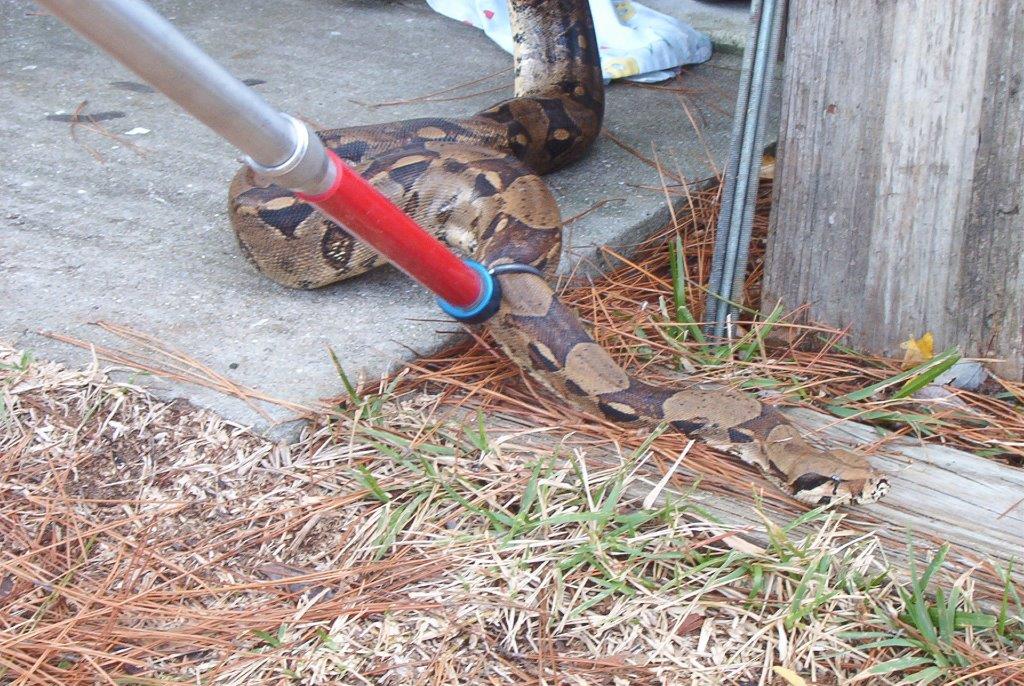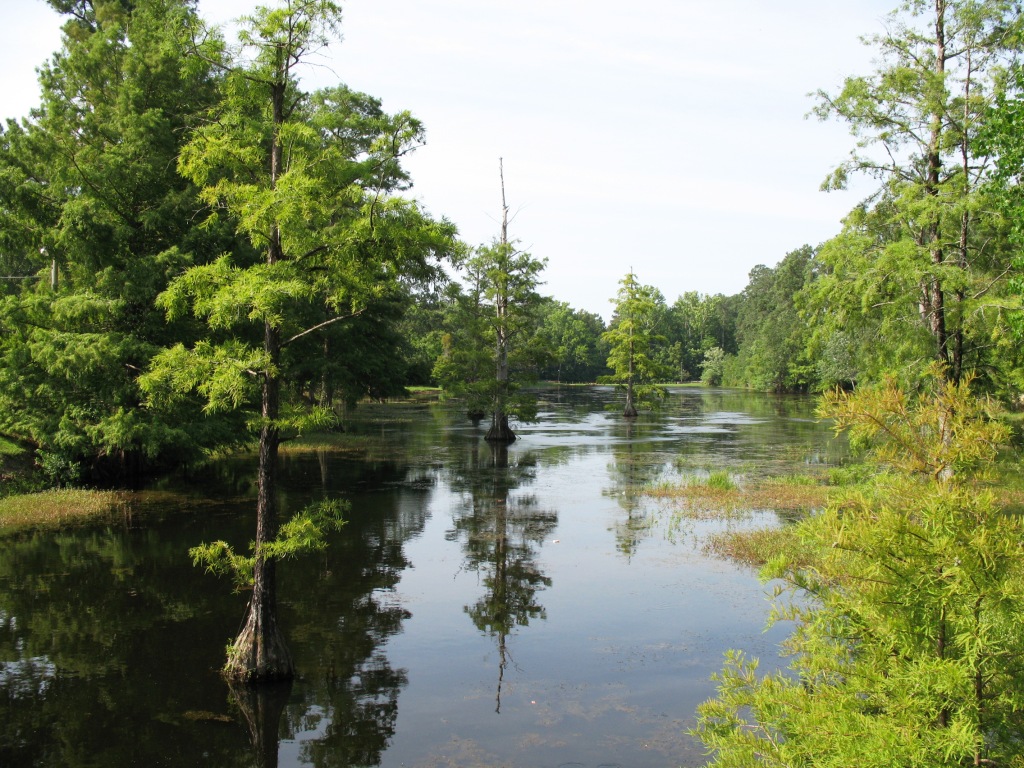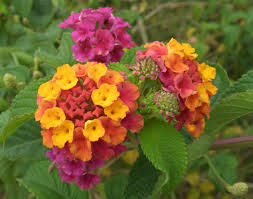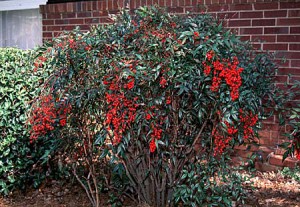
by Daniel J. Leonard | Nov 18, 2020
The native Florida landscape definitely isn’t known for its fall foliage. But as you might have noticed, there is one species that reliably turns shades of red, orange, yellow and sometimes purple, it also unfortunately happens to be one of the most significant pest plant species in North America, the highly invasive Chinese Tallow or Popcorn Tree (Triadica sebifera).

Chinese Tallow fall foliage. Photo courtesy of Daniel Leonard.
Native to temperate areas of China and introduced into the United States by Benjamin Franklin (yes, the Founding Father!) in 1776 for its seed oil potential and outstanding ornamental attributes, Chinese Tallow is indeed a pretty tree, possessing a tame smallish stature, attractive bark, excellent fall color and interesting white “popcorn” seeds. In addition, Chinese Tallow’s climate preferences make it right at home in the Panhandle and throughout the Southeast. It requires no fertilizer, is both drought and inundation tolerant, is both sun and shade tolerant, has no serious pests, produce seed preferred by wildlife (birds mostly) and is easy to propagate from seed (a mature
Chinese Tallow tree can produce up to 100,000 seeds annually!). While these characteristics indeed make it an awesome landscape plant and explain it being passed around by early American colonists, they are also the very reasons that make the species is one of the most dangerous invasives – it can take over any site, anywhere.
While Chinese Tallow can become established almost anywhere, it prefers wet, swampy areas and waste sites. In both settings, the species’ special adaptations allow it a competitive advantage over native species and enable it to eventually choke the native species out altogether.
In low-lying wetlands, Chinese Tallow’s ability to thrive in both extreme wet and droughty conditions enable it to grow more quickly than the native species that tend to flourish in either one period or the other. In river swamps, cypress domes and other hardwood dominated areas, Chinese Tallow’s unique ability to easily grow in the densely shaded understory allows it to reach into the canopy and establish a foothold where other native hardwoods cannot. It is not uncommon anymore to venture into mature swamps and cypress domes and see hundreds or thousands of Chinese Tallow seedlings taking over the forest understory and encroaching on larger native tree species. Finally, in waste areas, i.e. areas that have been recently harvested of trees, where a building used to be, or even an abandoned field, Chinese Tallow, with its quick germinating, precocious nature, rapidly takes over and then spreads into adjacent woodlots and natural areas.

Chinese tallow seedlings colonizing a “waste” area. Photo courtesy of Daniel Leonard.
Hopefully, we’ve established that Chinese Tallow is a species that you don’t want on your property and has no place in either landscapes or natural areas. The question now is, how does one control Chinese Tallow?
- Prevention is obviously the first option. NEVER purposely plant Chinese Tallow and do not distribute the seed, even as decorations, as they are sometimes used.
- The second method is physical removal. Many folks don’t have a Chinese Tallow in their yard, but either their neighbors do, or the natural area next door does. In this situation, about the best one can do is continually pull up the seedlings once they sprout. If a larger specimen in present, cut it down as close to the ground as possible. This will make herbicide application and/or mowing easier.
- The best option in many cases is use of chemical herbicides. Both foliar (spraying green foliage on smaller saplings) and basal bark applications (applying a herbicide/oil mixture all the way around the bottom 15” of the trunk. Useful on larger trees or saplings in areas where it isn’t feasible to spray leaves) are effective. I’ve had good experiences with both methods. For small trees, foliar applications are highly effective and easy. But, if the tree is taller than an average person, use the basal bark method. It is also very effective and much less likely to have negative consequences like off-target herbicide drift and applicator exposure. Finally, when browsing the herbicide aisle garden centers and farm stores, look for products containing the active ingredient Triclopyr, the main chemical in brands like Garlon, Brushtox, and other “brush/tree & stump killers”. Mix at label rates for control.
Despite its attractiveness, Chinese Tallow is an insidious invader that has no place in either landscapes or natural areas. But with a little persistence and a quality control plan, you can rid your property of Chinese Tallow! For more information about invasive plant management and other agricultural topics, please contact your local UF/IFAS Extension office!
References:
Langeland, K.A, and S. F. Enloe. 2018. Natural Area Weeds: Chinese Tallow (Sapium sebiferum L.). Publication #SS-AGR-45. Printer friendly PDF version: https://edis.ifas.ufl.edu/pdffiles/AG/AG14800.pdf

by Pat Williams | Oct 16, 2020
Pat is the County Extension Director and the Agriculture/Horticulture/Natural Resources agent for UF/IFAS Extension Wakulla County while also serving as the Master Gardener Volunteer Coordinator for both Franklin and Wakulla counties.

Pat by their outdoor mural at the Extension office.
He earned his doctorate from Texas A&M University in horticulture, a M.S. degree from Kansas State University in horticultural therapy, a B.S. degree in ornamental horticulture/floriculture from Cal Poly San Luis Obispo and an A.S. degree in ornamental horticulture from Crafton Hills College.
Over his horticulture career that started at age 13 working for Chrysanthemum Gardens in Crestline, CA, he has resided in 10 different states with a wide range of environmental influences (CA, KS, NJ, ME, NY, WA, TX, KY, TN and FL). He has held various positions in his career from teaching adults with developmental disabilities in NJ and ME, designing, installing and maintaining landscapes, landscape construction, being a horticultural therapist in New York City, working for the USDA in WA, teaching in a TX federal prison for his Extension appointment, teaching horticulture in a TN high school and was an university horticulture professor for 14 years in KY after teaching at Kansas State University, Washington State University and Texas A&M University as a teaching assistant. He started with the University of Florida/Institute of Food and Agricultural Sciences in April 2017 as the Sarasota County Residential Horticulture Agent/Master Gardener Volunteer Coordinator and transitioned to the Wakulla County Extension office in June 2020.

Kayaking the Myakka River, FL.
Teaching and greenhouse growing are his professional joys. Florida is the first state where there has not been a greenhouse to play in and he misses it greatly, however Extension does offer many opportunities to share his passion for plants and outdoors with a new group of learners. Otherwise Pat grew up on the beaches and ski resort areas of southern CA and still finds solace today relaxing on the beach or kayaking. He has traveled a bit visiting 49 states with only Hawaii to go. When indoors he would rather be baking or cooking in the kitchen as his second career choice would have been a chef. There is usually a yard full of flowers, herbs and vegetables and he is an extremely proud FSU Seminole Dad to Tara, a 2020 graduate.
Pat wears many hats at the Wakulla office and handles topics other than 4-H Youth Development or Family and Consumer Sciences. Once again he finds himself in a transition adapting to the new horticultural environment of Florida’s panhandle and developing more programs in agriculture and natural resources. Please feel free to reach out to see how the UF/IFAS Extension Wakulla County can be of assistance.

by Rick O'Connor | Mar 6, 2015

This exotic snake was caught in a garage on Bayou Chico (Pensacola) – it did not belong to the homeowner. Photo courtesy of: Escambia County Animal Control
Now that we have completed National Invasive Species Awareness Week many readers have learned what NOT to do with their unwanted exotic pets… but what DO you do with them? Here are six simple suggestions for you to consider. Many professional herpetologists suggest similar options.
- Keep it This may sound a bit strange but it is actually an option. Many who purchase an exotic pet do so without the understanding of how large they may get, or expensive they are to maintain. However if the owner does a little homework you may be able to design, or purchase, a enclosure for your pet that will make them more comfortable, easier for you to handle, and less expensive to maintain.
- Find a new home This is the most popular option. Listing the animal on the internet or in the local paper may yield a person very interested in having and properly maintaining it… a win-win for all. Other options can include nature centers and schools where education on invasive species may find a place that needs and wants the animal. There are rescue groups for specific species which can be found on the internet.
- Return to the pet store Many pet stores will take pets they have sold back for resale. This is certainly a better option than releasing it but pet owners should understand that they will probably will not get their money back.
- Contact your local animal control office Our local animal control will not take exotic pets but some may, and most can, provide good advice as to local locations that may be interested in it.
- Contact your local state wildlife agency Most state wildlife agencies are very familiar with non-profits, nature centers, and other locations that will accept exotic animals. In Florida the Florida Fish and Wildlife Conservation Commission offer Amnesty Days where residents can bring their unwanted exotic pets to a central locations; FWC will then try to find them a new home. To find the nearest Amnesty Day to your home visit the FWC website at MyFWC.com.
- Euthanize Though for most pet homeowners this is not an option, for some it may be their only option. If you do plan to euthanize your pet you should do so only with a certified veterinarian.
Whichever option the pet owner chooses, releasing them into the wild is NOT a good option. In addition to being against the law it could be lethal for your pet or, if they do survive, economically or environmentally catastrophic for your community.
These ideas and suggestions were provided by Dr. Steve Johnson, University of Florida Department of Wildlife Ecology, and the Southeast Partners in Amphibian and Reptile Conservation. For more information on what to do with unwanted exotic pets please visit their websites.
Fight Panhandle invasive species by visiting our action articles.

An unwanted green iguana now resides at the Roy Hyatt Environmental Center where others can learn about the issues of exotic pets. Photo: Molly O’Connor

by Rick O'Connor | Feb 20, 2015
The Everglades Cooperative Invasive Species Management Area (ECISMA) is organizing a nonnative freshwater fishing tournament for Invasive Species Week.
Begins: 6:00 AM Saturday February 21, 2015
Ends: 12:00 AM Sunday March 1, 2015
OBJECTIVES FOR TOURNAMENT
- Document the distribution of freshwater nonnative fish in Florida
- Increase awareness of the problem with nonnative freshwater fish
- Encourage anglers to target nonnative species
RULES FOR TOURNAMENT
- All anglers must register on EDDMaps – this is easy… visit http://eddmaps.org/
- When recording on EDDMaps all data must complete with exact location (GPS preferred) and include a photo. Photos should have fish flat on a light colored background, in shade if possible, head facing left, and extend the fins as much as possible.
- The boundaries for the tournament are all legally fished freshwater bodies of water in Florida
- All fish must be caught within compliance with the State of Florida regulations. Visit MyFWC.com/fishing/freshwater/regulations or visit a local bait and tackle shop for these.
- Native species are not eligible
PRIZES FOR TOURNAMENT
Most Unusual Catch – Adult
- First Prize – $75 gift certificate to Bass Pro Shop and Lionfish Be the Predator T-shirt
- Second Prize – $50 gift certificate to Bass Pro Shop and Lionfish Be the Predator T-shirt
- Third Prize – $25 gift certificate to Bass Pro Shop and Lionfish Be the Predator T-shirt
Most Species – Adult
- First Prize – $75 gift certificate to Bass Pro Shop and Lionfish Be the Predator T-shirt
- Second Prize – $50 gift certificate to Bass Pro Shop and Lionfish Be the Predator T-shirt
- Third Prize – $25 gift certificate to Bass Pro Shop and Lionfish Be the Predator T-shirt
Most Unusual Catch – Youth
- First Prize – $50 gift certificate to Bass Pro Shop and Lionfish Be the Predator T-shirt
- Second Prize – $25 gift certificate to Bass Pro Shop and Lionfish Be the Predator T-shirt
- Third Prize – $15 gift certificate to Bass Pro Shop and Lionfish Be the Predator T-shirt
Most Species – Youth
- First Prize – $50 gift certificate to Bass Pro Shop and Lionfish Be the Predator T-shirt
- Second Prize – $25 gift certificate to Bass Pro Shop and Lionfish Be the Predator T-shirt
- Third Prize – $15 gift certificate to Bass Pro Shop and Lionfish Be the Predator T-shirt
For a list of nonnative targets you can visit EDDMaps.com, MyFWC.com, or contact your local county Extension office. We encourage all participants to take and eat what you catch.
DISCLAIMER
It is expressly understood that participants in the 2015 Nonnative Fish Catch, Click, and Submit enter at their own risk and that Everglades CISMA and all participating organizations, Officers, Event Sponsors, and Committees, and all other persons connected directly or indirectly with the operation of said event, shall be exempt from any liability for liable, slander, loss, damage, negligence, harm, injury, or death suffered by any participant, entrant, vessel, and equipment, companions, and guests, boat captains, mates, or crew members, which may occur in conjunction with the 2015 Nonnative Fish Catch, Click, and Submit.
For more information contact ECISMA at http://evergladescisma.org/.

by Sheila Dunning | Feb 20, 2015
It’s Growing So Well It Must Be A Good Plant. Right?

Lantana camera
You know that plant in the corner of the yard that seems to be taking over? It’s the one that your friend “passed along” because they had plenty of them and wanted to share. After all, it grows so well. How can you go wrong? The odds are that vigorous plant is a non-native species. The majority of what is sold in nurseries are introduced from a foreign country and developed for their uniqueness.
The problem is that many of the plants brought into the United States arrive without their natural enemies. Under the long, warm growing season found in Florida, these non-native plants become the dominant plant in an area and manage to out-compete the native plants. When this happens, these introduced plants get labeled as an “invasive species”.

Nandina domestica
If you want to learn more about your friend’s ”passalong” plant be sure to visit the Assessment of Nonnative Plants in Florida’s Natural Areas website and database at http://assessment.ifas.ufl.edu/.

Ruellia brittoniana Mexican Petunia













